How to Use Narcan to Reverse an Opioid Overdose
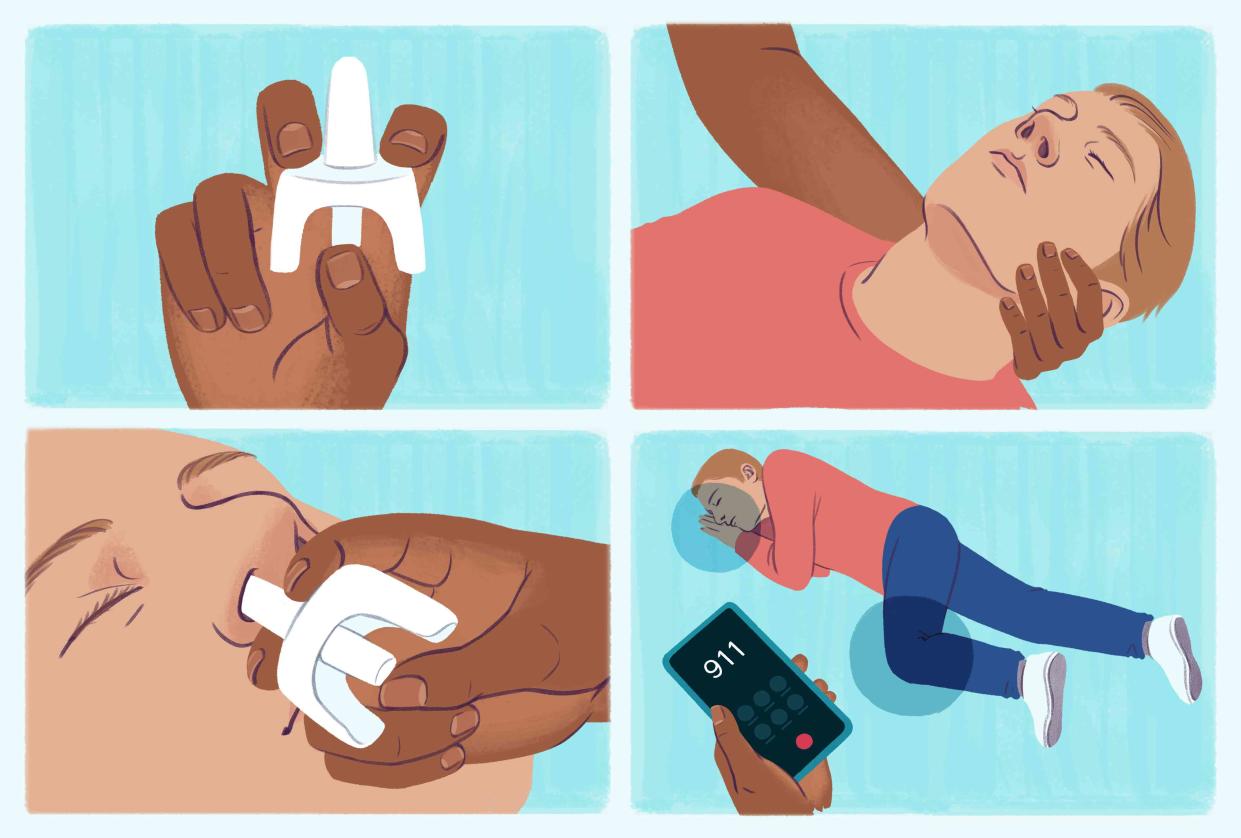
Illustration by Mira Norian for Verywell Health
- Oops!Something went wrong.Please try again later.
The opioid-reversal drug Narcan (naloxone) can now be sold over the counter, the Food and Drug Administration (FDA) announced Wednesday.
This is the first time naloxone has been made available without a prescription. The nasal spray will be available not only in drug stores, but also in convenience stores, grocery stores, gas stations, and online, according to the FDA. The medication will be sold in stores by late summer, the drug’s manufacturer said.
“Naloxone it’s really easy to give. It’s life-saving,” said Robert Baillieu, MD, MPH, a physician and senior advisor at the Center for Substance Abuse Treatment at the Substance Abuse and Mental Health Services Administration. “It’s really important. It means anyone who uses substances, or anyone who knows someone who uses substances, particularly friends or family members, has access to a life-saving medication.”
The United States is seeing a surge in drug overdoses, driven largely by the proliferation of fentanyl, a synthetic opioid that is highly fatal even at tiny doses. The National Institute on Drug Abuse recorded more than 106,000 overdose deaths in 2021. The majority of those involved fentanyl.
How Can You Tell If Someone Is Overdosing?
A person may be experiencing an overdose if:
Their breathing or heartbeat is slow or stopped
They seem unusually sleepy or unresponsive
They can’t speak
They vomit or make gurgling noises
Their body is limp
Their skin feels cold and clammy
Their pupils are small
Their nails or lips are blue or purple
If you suspect someone has overdosed, call their name or nudge them to see if they are responsive. If you can no longer see their chest rise and fall, they may be overdosing. You can also do a “sternum grind,” said Jose Martinez, a harm reduction associate with the National Harm Reduction Coalition. Use your knuckle and rub it in the middle of their chest, across their breastbone, and see if they respond.
You may also notice discoloration of the person’s skin, depending on their race. For instance, a Black person may have a grayish tint to their skin while a white person may start to appear blue or purple.
When in doubt, it may make sense to administer Narcan. Baillieu said Narcan is a “really safe” medication, even when given to someone who hasn’t overdosed on opioids.
Should You Call 911 Before Administering Narcan?
If you have Narcan available, use the spray first. The sooner Narcan is administered after a person shows signs of overdose, the more likely the person is to survive. Then you can call 911.
Narcan won’t permanently reverse an overdose. The person will likely need more naloxone and other medical care to fully recover, so you should call emergency services, even if the person wakes up.
Nearly every U.S. state and territory has good Samaritan laws, which protect people from criminal penalties if they call 911 to help someone who has overdosed.
How Should You Use Narcan?
Step 1
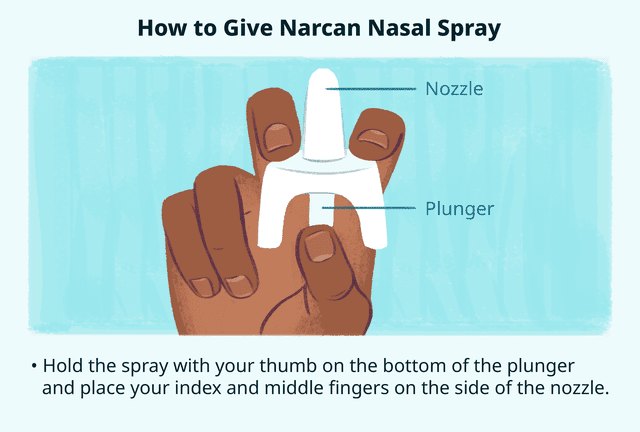
Illustration by Mira Norian for Verywell Health
Peel off the back of the Narcan package and remove the device. Hold the device in one hand. Place your thumb on the bottom of the plunger and your index and middle fingers on the base of either side of the nozzle.
Step 2
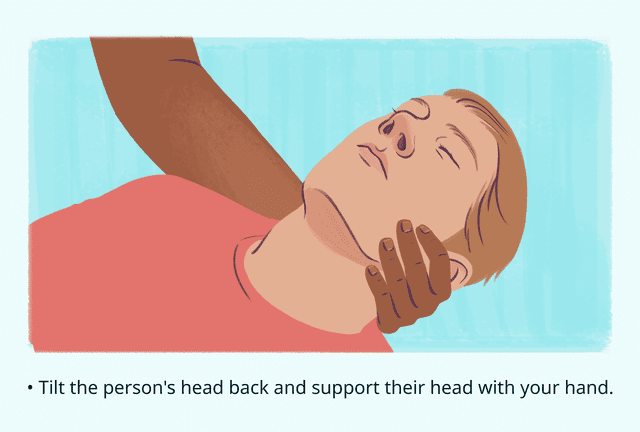
Illustration by Mira Norian for Verywell Health
Lay the person on their back, face up. Make sure their head is straight. Support their head with your hand.
Step 3
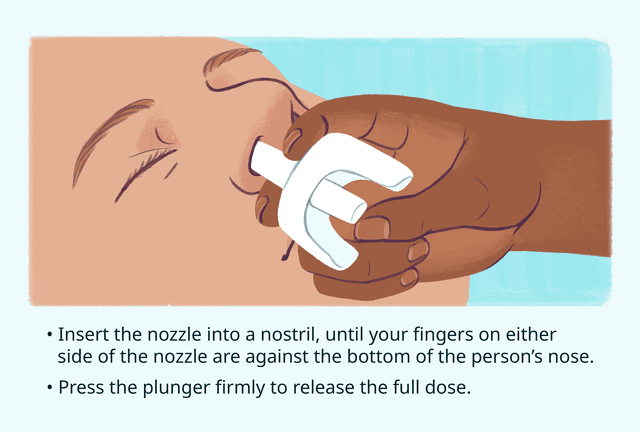
Illustration by Mira Norian for Verywell Health
Place the tip of the nozzle into one nostril until your fingers touch the bottom of the person’s nose. Hold the device steady, firmly press the plunger with your thumb. This will release a spray of the medication into the person’s nose.
Step 4
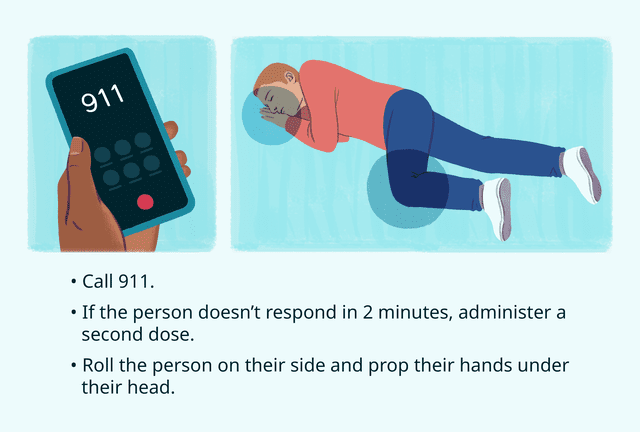
Illustration by Mira Norian for Verywell Health
Wait two to three minutes for the medicine to work. If you haven’t yet called 911, this is a good time to do so. Put the person in a “recovery position.” Roll them on their side, with their head resting on their hands and one knee bent out to the side to prevent them from rolling onto their stomach.
Until the person is breathing normally or EMS arrives, you can give them “rescue breaths.” Lay them on their back, tilt their chin up, and pinch their nose. Place your mouth on theirs to make a seal and give them two slow breaths. Repeat this every five seconds.
If the person’s breathing does not return to normal, or they continue to have difficulty breathing, they may need another dose. You may need to repeat this every two to three minutes until breathing returns to normal.
Stay near the person and closely watch them until medical help arrives. Dispose the Narcan device in an area away from children.
What Should You Do After Giving Narcan?
Narcan can reverse an overdose for 30 to 90 minutes, but opioids can stay in the body longer than that. During this time, the patient should not use additional drugs.
When the patient revives, it’s important to keep them calm and help them understand what happened, Martinez said. They may become agitated and need some time to get coordinated again.
People who are opioid dependent can experience symptoms of withdrawal within minutes of receiving Narcan. These may include:
body aches
diarrhea
racing heart
fever
runny nose
sneezing
goose bumps
nervousness, restlessness, or irritability
shivering or trembling
sweating
nausea or vomiting
abdominal cramps
weakness
increased blood pressure
“We want to be able to calmly explain to the person that they overdosed. Give them positive affirmations like ‘Thank God you’re alive,’” Martinez said. “They’re going through that hunger, where they want to use… and we’re telling them that they can’t. They have woken up probably surrounded by a bunch of people, so it creates certain emotions.”
Emergency medical responders may suggest that the patient goes to the emergency room or gets treatment for opioid use disorder after the overdose is reversed.
“Sometimes, people who use drugs don’t really have either a good relationship with or history with those kinds of environments, so that’s why we give them the option to go to the ER or not,” Martinez said.
The medication works by binding to opioid receptors in the brain and blocking the opioid medications from acting on them. Opioids act on a receptor in the brain that controls breathing. In the case of an overdose, a person’s breathing may slow to the point where they become unconscious.
Should You Get Narcan Before It’s Available OTC?
In most cases, a prescription is required for someone to access Narcan. In many states, providers will mail it to your home. In others, you can pick it up at vending machines.
Baillieu said SAMHSA has spent more than $1 billion in grants to support states’ efforts to curb overdose, including distributing naloxone. A simple Google search can tell you how to access Narcan in your state.
The drug manufacturer will set the price for over-the-counter Narcan. The medication is currently free or inexpensive to people covered by Medicare or private insurance. But insurers may not cover it when sold over the counter.
The FDA said it may later approve other brand-name naloxone nasal sprays and encouraged other manufacturers to apply for over-the-counter status for their products.
Martinez said that many people still stigmatize drug users. Making naloxone widely available could encourage more people to see the benefits of harm-reduction tools.
“It’s one thing to say, ‘you should carry X number of doses,’ and another to make it easy,” Martinez said. “This decision to make naloxone over the counter is really important so that people can access it easily. It helps with broader issues around communities’ involvement in looking after individuals who misuse substances, too.”
Ease of access to naloxone can be life-saving not only for persistent opioid users, but for those who unwittingly consume fentanyl and other opioids, too. Baillieu said there have been instances of marijuana being laced with these drugs.
Baillieu applauded the move to make naloxone more accessible to everyone. Still, the overdose crisis is multi-faceted and addressing it will require interventions from many angles, he said.
“Naloxone is one part of the puzzle. Decreasing opioid overdose is more than just treating overdose. It’s looking at the social determinants of health that lead to substance misuse. It’s looking at access to treatment. It’s looking at addiction counseling. It’s looking at all of those things that can help an individual and communities.”
Anyone seeking treatment options for substance use or mental health disorders can call the Substance Abuse and Mental Health Services Administration (SAMHSA) National Helpline at 800-662-HELP (4357) or visit findtreatment.gov.

